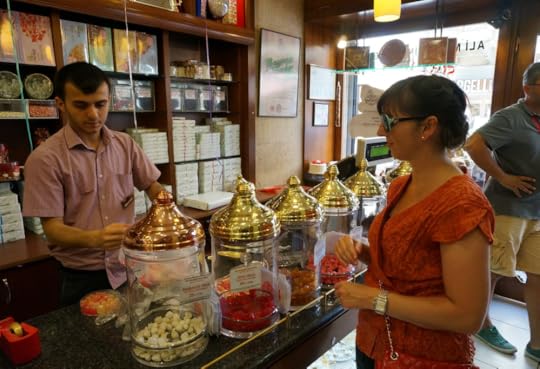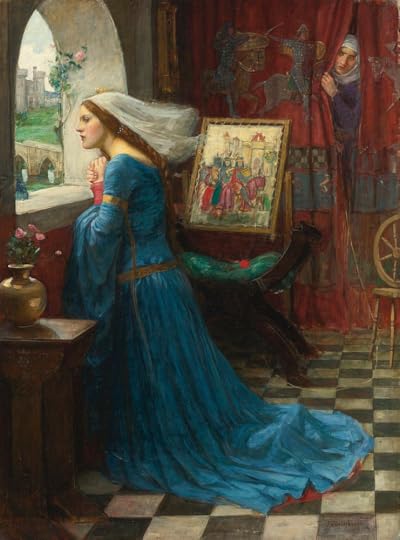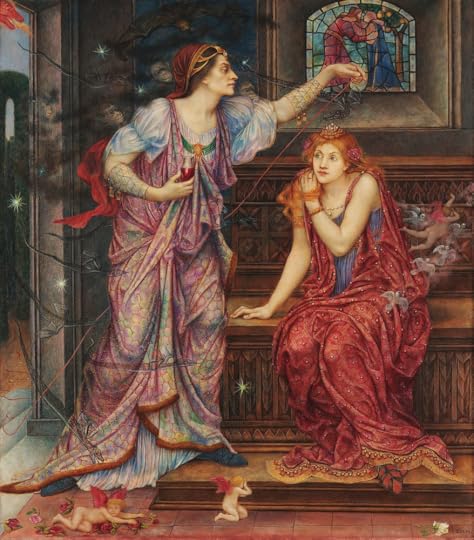Tammy Lowe's Blog, page 6
July 26, 2023
Interesting Fact of the Day...
The Bruges Swans

It's 1482.
Mary of Burgundy is in a tragic horse accident while on a hunting trip to Bruges in Flanders.
Mary is the wife of Emperor Maximilian of Austria.
Upon learning the news, Emperor Max hops on his horse, rushing to her side. He arrives...only to discover his beloved wife, Mary, has died.
Overcome with grief, he unleashes his anger on the people of Bruges, for he now despises the city where his wife died.
Wanting them to suffer, as he now suffers, Emperor Max takes away privileges and imposes heavy taxes. He instructs his right-hand man, Pieter Lanchals, to enforce his wrath.
Now, the awesome thing about Flemish people historically is...they don't put up with any crap.
What did they do?
Well, first they arrested the right-hand man, Pieter Lanchals.
Then, when Emperor Max comes back to Bruges, they basically give him the middle finger...before throwing him in jail too.
From the Emperor's prison cell overlooking the market square, he is forced to watch the townsfolk torture and behead Lanchals.
Then, the people of Bruges let Emperor Max go, booting him out of town.
Of course, the emperor is irate at the murder of Pieter Lanchals.
"Bruges...I condemn you," Maximillian cries out before fleeing to Austria. "You are henceforth cursed to keep *Lanchals* forever...and may they breed in your canals for all time," he hisses.
Lanchals means "Long Neck" in Old Dutch.
And, Pieter Lanchal's family coat of arms included a swan.
To this day, you can still find the legendary "Lanchals" in the canals of Bruges— the swan city.
Story-time...
Turkish Delight

I don't know about you, but I LOVE Turkish Delight.
We're in Istanbul with our historian, Erkan. Every morning he comes to our hotel lobby to pick the three of us up, taking us sight-seeing and answering my endless questions.
"Where can I buy the best Turkish Delight in all of Turkey?" I ask Erkan. "I'd like to bring some home as gifts."
So, we head to a 240 yr. old sweet shop called “Haci Bekir” off Taksim Square and, along the way, Erkan tells me the amusing history of Turkish Delight.
In 1777, a man name Haci Bekir moved to Constantinople (Istanbul) and opened up this confectionary shop. His little jellied sweets called "Lokum" became so popular, everyone in the Ottoman Empire wanted them.
The recipe was kept secret for generations, but it contained a brand new secret ingredient called...cornstarch.
The Sultan, Mahmud II, was completely obsessed with "lokum".
"Bring me Haci Bekir, for I shall appoint him Chief Confectioner to the Palace," he said. (Okay, I'm paraphrasing the Sultan.)
A few years later, a British tourist comes to town and buys a bunch of boxes of "lokum" from the quaint confectionary shop to bring home with him.
When he gets back to London he passes the sweets around.
"The people of Constantinople love these," he tells all his friends. "The confectioner who makes these makes ALL the sweets for the palace."
"Mmmm. What's it called?" his friends ask.
"Oh dear...I don't recall," he replies. "But it certainly is a...Turkish Delight."
*insert polite British laugh here*
And to this day, the rest of the world calls locum...Turkish Delight.
Story-time...
Come with me if you like and I'll tell you a tale.

We're in Brussels, in this big gothic cathedral. I spot a rather odd statue of a couple, and the Virgin Mary, in a rowboat.
With a bewildered look on my face, I point to it. "What's this about?"
The legend goes like this:
It's 1348, Flanders. Where the church stands today, there's a modest guild hall belonging to the crossbowmen with a little chapel dedicated to Our Lady.
One day, the Virgin Mary appears to a young woman named Beatrice. Mary tells Beatrice to go to Antwerp and STEAL a statue of her called, "Our Lady on the Little Stick". She's to bring it back to Brussels because *this* is where she really wants it.
So, the devout Beatrice immediately grabs her husband. They hop in their little boat and row all the way to Antwerp. Once there, she finds the church, steals the statue of "Our Lady on the Little Stick", and runs to the get-away boat where hubby is waiting.
Unfortunately, there's no wind. The boat barely moves. Hubby keeps paddling, but to no avail. The townspeople and the priest are closing in, determined to take their beloved statue back.
And that's when a miracle occurs.
The wind picks up and pushes the little rowboat away. *gasp*
Beatrice arrives back in Brussels and places the statue in the chapel at the Crossbowmen Guild.
Upon hearing about the miracles that took place, people begin to flock to see the statue here. The guild promises to hold a weekly procession, called the Ommegang, and carry the statue throughout the streets of Brussels. Meanwhile, donations pour in from believers and, over the years, they're able to build a bigger church.
In Brussels, the Ommegang Festival still continues to this day.
And there you have it. Your interesting, but useless fact of the day: Beatrijs Soetkes and the Church of the Blessed Lady of the Sablon.
July 25, 2023
Interesting Fact of the Day...
The Devil's Thumb

Come with me to Aachen, Germany.
I'm waiting and waiting to take a photo of these doors, but the two adorable old men wouldn't move.
I knew why though.
They were searching for the Devil's Thumb.
You see, way back in the year 796, Charlemagne wanted a huge, beautiful Cathedral built here. He ordered the townspeople to have it finished by the time he came back from war with the Saxons. He then rode off, leaving the town council in charge.
This was an impossible task since cathedrals take generations to build. The townspeople were like, "Holy crap! We can't have this done before Charlemagne gets back. We don't even have enough money!"
They worked like mad, but half-way through construction, the city coffers ran dry. They ran out of money. They were freaking out, needing to finish before Charlemagne- Charles the Great himself- got back.
One day, a man comes to town. "Don't worry," he tells the people. "I'll give you the money to build your cathedral. The only thing I want in return is the soul of the first person to walk through the doors when it's complete."
The townspeople can see this is a deal with the Devil, but...they're desperate. They agree. They'll figure a way out of the deal later. The Devil gives them the much needed money and they continue building the church.
Eventually, Charlemagne sends word he's coming home to Aachen...and he's bringing his buddy, Pope Leo III with him, to consecrate it.
This means the Pope will be the first person through the doors. *gasp*
They finish the beautiful cathedral on time, building it in a record NINE years, from 796-805. (Legend aside: this is an absolutely incredible feat.)
Meanwhile, a monk comes up with a plan to outwit the Devil and save the soul of Pope Leo. In no part of the deal was it mentioned the soul had to be human. If they let a wolf in the doors first, the Devil will grab that instead of the Pope.
So, opening day comes with all the pomp and circumstance of having the beautiful Aachen Cathedral opened. The Devil is super excited. He's hiding behind the huge doors (as seen in the photo), just waiting to pounce on Pope Leo III and take his soul.
But, the townspeople sneak up and let a she-wolf in first.
As it runs through the doors, the Devil grabs the wolf, laughing as he rips out the soul.
He then realizes his mistake and is so furious, he storms away, returning to Hell, but not before slamming the front doors as hard as he can--slicing off his thumb in the process.
His thumb is still there to this day...now hard as iron.
And the fact these two men spent forever searching for it makes me smile.
Interesting Fact of the Day
Here's an interesting fact of the day for you.
I think almost everyone knows this really fun song, Funiculi, Funicula.
https://youtu.be/0oxBfcwQQ4QComposed in 1880 by a man named Luigi Denza, it was for the opening of a funicular railway that ran to the top of Mt. Vesuvius. The song is about a guy in love with a girl named Anna. He's trying to talk her into going to the summit of the volcano with him for a romantic stroll.
Anyhow, the song became a huge hit, selling over a million copies of sheet music within a year. (This is the 1800's after all.)
A few years later, the famous German composer Richard Strauss comes to Italy and hears the song while in Naples. He loves it! Believing it's a traditional folk song, he adds it to part of his latest piece, Aus Italien.
Luigi, the Italian composer hears it and says, "What the heck? That's my song!" So he sued and of course won. From that day forward, whenever Strauss' orchestra played Aus Italien...Luigi received royalties.
Story-time...
The Legend of Rosa Mundi

Rosa Mundi (from my very own garden)
Rosa Gallica Versicolor
THE HISTORY:
The longest cultivated rose in human history is called the Apothecary Rose or the Red Provence Rose. It has been found on fresco's dating all the way back to 1600 BC.
It's also a well-known fact the ancient Romans LOVED roses.
In the medieval era, the Apothecary Rose became the most common rose grown and one day, a sport was born. A sport is a genetic mutation and in this case, the result was a pink striped beauty as seen in the photo.
THE LEGEND:
In the 12th century, there lived a beautiful woman named Rosamund Clifford; the mistress and true love of King Henry II. Henry built an elaborate garden maze and in the center was a cottage, a beautiful garden, and a bathing pool for his fair Rosamund. This entire setup wasn’t just for their liaisons, but to hide and protect her from his wife, the very powerful, Queen Eleanor of Aquitaine.
But, word got back to the Queen about the affair and one day she watched King Henry exit the maze. Unbeknownst to him, a silk thread from his clothing had become unraveled and it led Eleanor through the maze and directly to Rosamund.

Fair Rosamund (John William Waterhouse)

Queen Eleanor and Fair Rosamund (Evelyn De Morgan)
Determined to end the affair permanently, the Queen offered Rosamund a choice: death by poison or by knife.
Rosamund chose poison.
King Henry had her body sent to a nunnery near Oxford and every year, on the anniversary of Rosamund's death, her tomb was to be decorated with masses of this pink striped rose known to this day as…Rosa Mundi.
Needless to say, as soon as I read about this legend, I had to get my hands on a this romantic rose for my own garden.

Interesting Fact of the Day...

Flowers grown from seed in my garden
This long-stemmed, pale pink bloom, with the wonderful scent of sugar and cloves, is a French heirloom variety from the early 19th century. Alongside roses, it is one of the oldest cultivated and beloved flowers in our history- the carnation.
Much like roses, its reputation was marred in the 1970’s, due to garish, non-scented varieties found in every grocery store and gas station, but THIS ruffled, scented delight is what the carnation is meant to be.
These flowers have been cultivated for at least 2000 years. An old fresco of carnations once graced the wall of a house in Pompeii.
It was said to be the favourite flower of the Greek goddess of hunting, Diana, hence their genus name “Dianthus“.
Because they were so revered by Diana, the Romans (who loved anything Greek) would wear crowns of carnations around their head. It was THE flower of coronations.
After Shakespeare himself wrote about it being a coronation flower, the word eventually evolved into...carnation.
Interesting Fact of the Day...
Alnwick Castle's Poison Garden

If you're a Downton Abbey or Harry Potter fan, you might recognize this castle.
Alnwick Castle.
But, did you know it's home to the world's most dangerous garden?
Beyond locked gates are more than a hundred deadly plants. There is one that if you touch the leaves, your skin will burn and blister...for seven years. One of their gardeners once reached in to pull out a weed and suffered third degree burns.
In 2014, a 33-year-old gardener died from multiple organ failure after touching Devil's Helmet.
Ricin, cyanide, and strychnine...they're all here.
One flower, when taken in small doses, causes hallucinations. In the Victorian Era, some women would grow this flower and keep it on their table. When they'd have ladies over for afternoon tea, they'd sneak a little pollen into the pot and wait for their guest to start talking gibberish.
You can actually tour the infamous poison garden, if you so dare... https://www.alnwickgarden.com/the-garden/poison-garden/
July 24, 2023
Story Time...

Here's a story for you, so if you'd like, grab a cup of tea and settle in.
My husband, Gord, is driving on the wrong side of the road, through the Scottish Highlands. It’s just like you’d imagine—craggy hills, ancient trees, herds of sheep in almost every field, and cattle so enormous you stop the car to take photographs of them.
While here, we’re going to be brave, ditch the luxury hotel suites, and “rough it”.
Well…sort of.

Although no longer open to the public, we’re able to spend the night in the tower room of an old castle--Kilvarock (pronounced kill-rock).
Located between Inverness and Nairn, the tower was built by Hugh Rose, the 7th Laird, in 1460. It’s near Loch Ness, Culloden Battle Field, and Clava Cairns standing stones. The mansion house was added in the 17th century.
All throughout the Highlands you can feel magic in the air, quickly understanding why so many legends come from this part of the world. I wonder if we’ll stumble upon Brigadoon, the enchanted village that appears for one day every hundred years. Believe me; I’ll dance around the heather with Gene Kelly in a heartbeat.
After arriving at Kilvarock, we are led up flight after flight of stairs through the main house, passing enormous rooms, including a dining hall that looks like it hasn’t changed in three hundred years. You can sense the ghosts of by-gone eras lingering in the corridors. Mary, Queen of Scots stayed here in 1562, and Bonnie Prince Charlie for four days before the Battle of Culloden.
The rest of the time, it’s the strangest feeling—being in an empty castle with a handful of staff we only hear, but never see.
We reach the top floor of the mansion house, now entering the stone tower through a heavy door.
We follow a steep spiral staircase as it continues up, up, up.
Behind a low, arched doorway is our chamber. Inside is an enormous medieval looking bed, the likes of which haven’t been seen since Ebenezer Scrooge’s time.
It’s incredible, looking out the window way up in our tower. Just call me Rapunzel, because that’s who I feel like.
But, come night-time, amusement turns into apprehension. You see…I need to go pee.
Of course, there’s isn’t a toilet in the tower.
In the pitch black, the arched wooden door in our room seems eerie, like a portal.
I tiptoe over and slowly open it.
The cold, stone staircase beyond is now terrifying.
If I’m ever going to encounter a ghost…it’s going to be here. I need to head out of the room, into the stone stairwell, and back into the mansion house for the nearest bathroom. Honestly, I don’t know what’s scarier: the way the ancient tower stairs disappear into the darkness or the corridors in the house at night. They look like the setting in some gothic novel—Wuthering Heights or Jane Eyre.
I’ve absolutely zero intention of running into the ghosts of either Heathcliff or Bertha Mason.
Forget that.
I jump back into bed.
I’ll hold it ‘till morning.
There are two ways to exit the tower. Leave the room through the mansion house, or down the circular stairs, right to the bottom. Be careful though—they’re uneven. In the event of a sword fight or ambush, only those familiar with this tower know how to move up and down the steps effortlessly.
The next morning, we set sail on Loch Ness.
A lone piper plays as we drift off into the mist, searching for Nessie. The cold, inky water moves in a way that makes you feel like something is following the boat from the depths of the loch. Every ripple and wave causes you to do a double-take.
“Are those humps in the distance?” my son, Quinton, and I wonder.

Just like the castle ghosts the night before, if there was ever going to be a mythical creature on Earth, it would be here. No wonder Nessie sightings date all the way back to the sixth century.
What stands out about the Scottish Highlands most is that everything seems only half in our world—the other in some sort of fairyland. Even the sky feels different, like it’s reaching right down to touch the earth.
So, if you ever visit the Highlands of Scotland, go with a sense of wonder.
Or better yet, bring a child.
You never know…the standing stones might buzz, Nessie could appear on the crest of a wave, and it might even be the day Brigadoon and its villagers appear in our world.
And I wouldn’t be in the least bit surprised.
Interesting Fact of the Day...

Unlike the history of the scandalous fork I told you about previously, the knife is one of the oldest utensils. You’d sit at the table; unsheathe your hunting knife to cut your meat, stabbing to pick it up.
The sharp tip was also handy for picking your teeth...or killing an enemy.
The blunt ended table knife we know today happens to be tied in with my favourite trio of guys, the Musketeers.
The Musketeers were an elite team of personal bodyguards to the French King. Cardinal Richelieu was the King’s closest advisor (and the villain in the stories). Tired of seeing knives pointed at him and disgusted watching guests pick food out of their teeth, in 1637, he convinced King Louis to ban sharp knives at the table. Instead, the tips must be ground down.
And that was the birth of the blunt dinner knives we set the table with today. To curb violence--and the picking of teeth.



